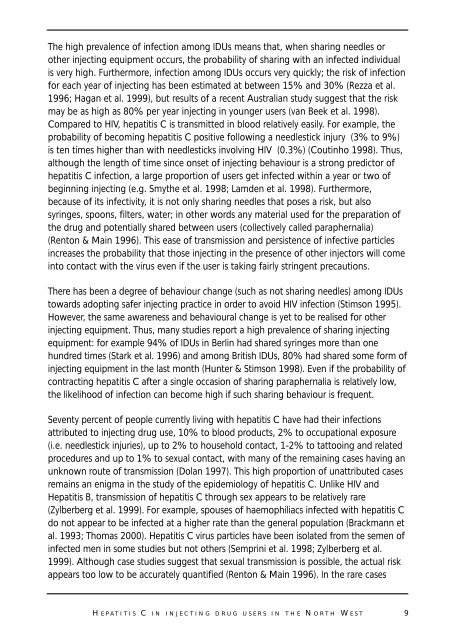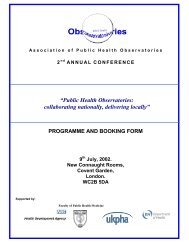9261 HEPATITIS C REPORT GALLEY - North West Public Health ...
9261 HEPATITIS C REPORT GALLEY - North West Public Health ...
9261 HEPATITIS C REPORT GALLEY - North West Public Health ...
You also want an ePaper? Increase the reach of your titles
YUMPU automatically turns print PDFs into web optimized ePapers that Google loves.
The high prevalence of infection among IDUs means that, when sharing needles or<br />
other injecting equipment occurs, the probability of sharing with an infected individual<br />
is very high. Furthermore, infection among IDUs occurs very quickly; the risk of infection<br />
for each year of injecting has been estimated at between 15% and 30% (Rezza et al.<br />
1996; Hagan et al. 1999), but results of a recent Australian study suggest that the risk<br />
may be as high as 80% per year injecting in younger users (van Beek et al. 1998).<br />
Compared to HIV, hepatitis C is transmitted in blood relatively easily. For example, the<br />
probability of becoming hepatitis C positive following a needlestick injury (3% to 9%)<br />
is ten times higher than with needlesticks involving HIV (0.3%) (Coutinho 1998). Thus,<br />
although the length of time since onset of injecting behaviour is a strong predictor of<br />
hepatitis C infection, a large proportion of users get infected within a year or two of<br />
beginning injecting (e.g. Smythe et al. 1998; Lamden et al. 1998). Furthermore,<br />
because of its infectivity, it is not only sharing needles that poses a risk, but also<br />
syringes, spoons, filters, water; in other words any material used for the preparation of<br />
the drug and potentially shared between users (collectively called paraphernalia)<br />
(Renton & Main 1996). This ease of transmission and persistence of infective particles<br />
increases the probability that those injecting in the presence of other injectors will come<br />
into contact with the virus even if the user is taking fairly stringent precautions.<br />
There has been a degree of behaviour change (such as not sharing needles) among IDUs<br />
towards adopting safer injecting practice in order to avoid HIV infection (Stimson 1995).<br />
However, the same awareness and behavioural change is yet to be realised for other<br />
injecting equipment. Thus, many studies report a high prevalence of sharing injecting<br />
equipment: for example 94% of IDUs in Berlin had shared syringes more than one<br />
hundred times (Stark et al. 1996) and among British IDUs, 80% had shared some form of<br />
injecting equipment in the last month (Hunter & Stimson 1998). Even if the probability of<br />
contracting hepatitis C after a single occasion of sharing paraphernalia is relatively low,<br />
the likelihood of infection can become high if such sharing behaviour is frequent.<br />
Seventy percent of people currently living with hepatitis C have had their infections<br />
attributed to injecting drug use, 10% to blood products, 2% to occupational exposure<br />
(i.e. needlestick injuries), up to 2% to household contact, 1-2% to tattooing and related<br />
procedures and up to 1% to sexual contact, with many of the remaining cases having an<br />
unknown route of transmission (Dolan 1997). This high proportion of unattributed cases<br />
remains an enigma in the study of the epidemiology of hepatitis C. Unlike HIV and<br />
Hepatitis B, transmission of hepatitis C through sex appears to be relatively rare<br />
(Zylberberg et al. 1999). For example, spouses of haemophiliacs infected with hepatitis C<br />
do not appear to be infected at a higher rate than the general population (Brackmann et<br />
al. 1993; Thomas 2000). Hepatitis C virus particles have been isolated from the semen of<br />
infected men in some studies but not others (Semprini et al. 1998; Zylberberg et al.<br />
1999). Although case studies suggest that sexual transmission is possible, the actual risk<br />
appears too low to be accurately quantified (Renton & Main 1996). In the rare cases<br />
H EPATITIS C IN INJECTING DRUG USERS IN THE N ORTH W EST<br />
9











